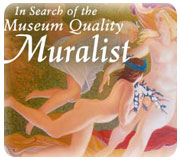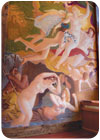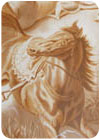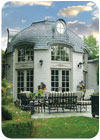
Known only in exclusive circles, the museum quality muralist lives to paint artistic legacies worthy of existence long past the commissioning party's lifetime. Paying homage to the great artists of past ages, MQMs carry on with the tradition of architectural perspective, humanity, nature and grand theater for the satisfaction of the old and new patrons of expensive tastes and style (a.k.a. the "A-list").
1. Just what is a museum quality muralist?
An MQM is a formally trained artist that works with the building and interior design trades to provide the highest degree of artistic workmanship within construction schedules and budgets with the absolute finest of details, timelessness and artwork worthy of international reputation.2. What qualifies an artist as an MQM?
An MQMs skills can come from a number of fine and technical art backgrounds; my skills have come from being a commercial and fine art painter, medical illustrator, technical and mechanical illustrator, professional photo retoucher, college art professor and passionate lover of classical art and architecture.
3. Does part of training include professional photo retouching?
Prior to Photoshop, all photo retouching was done by hand, everything from retouching 100-year old heirloom photographs to very expensive dye transfer prints of new cars in the high-stakes market of automobile advertising. Every aspect of a photograph was fair game for visual enhancement, substitution or replacement. The experienced commercial photo retoucher is capable of painting a photo realistically. Museum quality muralists with this skill-set can paint almost anything.Also, a handful of MQMs have been medical illustrators, who work with physicians, hospital department heads and book publishers to produce precise line drawings and full color renderings for medical textbooks, patient information and trade show displays. These MQMs are particularly keen on the proportions of human anatomy.
4. What resources do MQMs draw upon for their resources?
They draw upon the collective resources of their own personal references, libraries, client's books and clippings, Internet, the style of the house, the degree of craftsmanship, and the feeling and energy they absorb from the interior they're painting.For a reference library, an ideal collection would contain the picturesque, obscure, Renaissance art, architecture, ballet, Americana, mythology, fairy tales, legends, folklore, old industry, engravings, Baroque, Rococo, Art Deco, warfare, exotic animals, Maritime, fashion, theater, cinema, patterns and motifs and religious symbology.
5. What do MQMs look for in an assistant?
Assistants that MQMs look to work with do not necessarily need to know how to paint but they do require an even temperament, willingness to learn and have a skill showing fine motor skills in technical drawing, and Exacto knives to assist in the crucial aspects of surface preparation, mask cutting and detail layer image production. Further skills such as airbrushing, materials and techniques can be taught on the job as situations arise.
6. Those unfamiliar with proper planning and execution may target the MQM to cut out "non-essential" steps and processes to save time and money.
Short cutting of any aspect of an MQM's work is akin to masonry without stone. All aspects of design, planning and execution must be employed in the creation of a museum quality mural or the missed steps are obvious. A legitimate museum quality mural is produced to impress the world traveler who has been to Europe, the castles, major museums and has antique collections with pieces appraised in the tens of thousands of dollars. These luxury consumers can spot shortcuts in production instantly. They are those A-list clients that the MQM looks to work for.7. By the nature of construction a MQM is at the end of the construction schedule and of the first to feel the economic cutbacks at the end of a job. Further thoughts?
Our finished product can be the most original and impressive piece of custom work that a home can have. An MQM is expensive, so coordination and planning for an MQM should be planned and budgeted for very early in new home construction plans.8. What are considerations specific to the field that increase costs?
Cost increases/more expensive jobs are due to complex compositions, delicate color variations, fine textures, original designs and drawings, mask cutting, committee decisions involving anything, mockups, day/night viewing considerations. Typically, the more detailed the job, the more expensive the commission.9. What are some interesting types of spin-off work?
Mural restorations, framed art commissions, Heirloom photograph restorations, historic materials replication, intricate and delicate faux finishing, interior color adjustments, gold leaf, detailed furniture painting, limited antiques restorations and digital photographic concepts.10. Some of the work done is expansive. Is there an advantage to working higher up?
Above the height of 8 feet, images do not have to be as distinct. The mind tends to fill in the visual blanks and response is based more on recognition than on clarity. Some domed assignments starting up high have gone much faster than typical room projects with standard dimensions.11. What can be said about the amount of detail and scrutiny at regular wall and ceiling dimensions?
Where all the detail is 8 feet or below, there comes a natural curiosity to inspect followed by a natural option to comment, compare and make criticism. Everything at a normal viewing distance is severely scrutinized by those looking for the very best, so it is absolutely critical when constructing a museum quality mural that there are no shortcuts or omissions to detail.
12. What is meant by "protection from embarrassment"?
We bring up the critical points of drawing accuracy, composition, color harmony, psychological impact and timelessness that MQMs can offer on a daily basis that lesser artists can only hope to achieve. In true houses of quality, the museum quality mural is the true standard by which the taste of the homeowners is set and compared. A poor choice of muralist lowers the quality of all the other finished trades involved in the house. The involved trades should protect their good names by knowing the existence of available MQMs and make recommendations to the homeowner/interior designer as soon as possible. This phrase involves the MQMs ability not only to satisfy the tastes of the homeowner but also to exceed the standards of his fellow MQMs, whose judgments and criticisms amongst themselves are quite severe.13. What types of surface preparations do MQMs prefer?
Unless the artwork can be produced offsite on canvas and worth the effort to glue canvas on the walls and ceiling, a MQM will depend on artist's acrylic gesso, the same used on framed art canvases, for its flexibility, toughness and textural qualities. The MQM may apply multiple coats of crisscross layers of gesso to create the fine linen finish that is required to produce the surface texture that will showcase the art. For skyscapes in domes the gesso is applied in a swirled but consistent manner to give the surface a free and dynamic substructure, whose swirls and uplifting inspiration can be revealed at any time.Stated plainly, an MQM would not work directly on a plainly primed surface of any sort. Any prospective muralist who says its OK to work directly on a surface that they don't prime themselves does not care enough about his own work.
14. What types of paints are used?
For versatility and ease of use, MQMs typically employ acrylic paints, often in tandem with opaque watercolors, which are erasable and highly controlled.This tandem usually speaks well for the ethereal, daydream types of painting styles, particularly in interiors that have no heavy colors, fabrics, metallics, or deep wood tones. For deeper or more robust interiors, oils can be used, particularly if a painting style requires a buttery more painterly effect. Oils require an extended production schedule to reduce the odor as move-in-day draws closer.
15. What types of clearcoats are used?
The clearcoat that an MQM decides to use is based purely on what types of paints were used in making the art, any further color additions and enhancements anticipated in the future, and the aging properties/characteristics/patina of the specific clearcoat. Environment also plays a large part in decision-making, as clearcoats used in Kansas are not going to respond the same way in Maine or Florida.16. There is an interesting use for housewrap in more complex assignments.
I use Tyvek Housewrap extensively in planning, from masking to removable mockups to wrapping entire rooms to paint detailed full color sketches for client approval. Tyvek has an excellent linen finish that when properly primed will accept paint. The fine linen finish that Tyvek has provides the standard texture that MQMs strive for when preparing all walls and ceilings at standard heights.17. What kinds of products are used?
- Fine Detail Airbrushes: Iwata HP-B, HP-C, and HP-SB, also Paasche V1 gravity feed airbrushes
- Mid Detail Airbrushes: Iwata HP-BPS siphon feed airbrushes
- Broadstroke/Background Airbrushes: DeVillbis 8-ounce touch-up guns
- Compressed Air Sources: Porter Cable 25 Gallon Standup Compressor, 20-pound carbon dioxide tanks with pressure regulator valve and internal tank pressure valve
- Fine Detail Paintbrushes: Winsor Newton Series 7 Red Sable watercolor brushes
- Surface Prep Brushes: Sherwin Williams
- Surface Primers: Purdy Surface Primers, Sherwin Williams Alkyd and Acrylic Masonry Primers
- Liquid Linen Finish: Utrecht White Acrylic Artist's Gesso
- Intermediate and Finish Clearcoats: Minwax Polycrylic, Krylon Matte Clear Lacquer, Utrecht Matte Medium, Coronado Clear Dull Polyurethane
- Acrylic Paints: Liquitex Artist's Acrylics, Utrecht Artistls Acryl-ics Opaque
- Watercolor Paints: Winsor Newton Gouache and Rowney Gouache
- Gold Leaf and Support Products: Items available at Sepp Leaf
- Paint Removal and Modification Systems: Q Tip Cotton Swabs, cheesecloth, kneaded erasers and eraser pencils, various brands
- Airbrush Masking Films: Clear and Frosted Acetates, .003 to .075 mil depending on usage, various widths, available brands, etc.
- Large Conceptualization and Mock Up Support: Tyvek Housewrap
- Mask Cutting Tools: Exacto standard handle with #16 offset angle blades
- Taping Systems: 3M blue and Scotch 910 and 911
- Transparent Tapes Pencil Detailing Systems: 4H and 6H standard pencils and mechanical leads, available brands
18. What can a person do to break into the business?
Majoring in fine art with a concentration in drawing or painting is an excellent start. One must pick up airbrushing skills almost completely on their own, along with traditional, not digital, photo retouching techniques. The anatomical and scientific aspects may be acquired amongst a handful of graduate and undergraduate university programs across the country.As a suitable portfolio and reference library are compiled, introduce yourself to architects, builders and interior designers in order to get advice from them, maybe even a part time job, hopefully on big expensive job sites. From there you may be put in touch with the residential painters, faux finishers and specialty painters, and then the muralist for the house, at which time you express your intent to become an assistant.
19. What can be done in a million-dollar house?
Architecture and budgets often set restrictions on what can actually be done in a house of this price range. Key areas for consideration are foyer ceilings, large slant ceilings, upstairs hallway bridges, master bathrooms, master bedrooms, and sofa-sized commissions.20. How much can be done offsite?
A great deal can be provided offsite as long as the canvas attachment process to the wall or ceiling is trouble-free, with seams easily concealed, both by texture and color. The full size or large-scale color sketch has to be produced onsite with as much detail as humanly possible.If you read this article, please circle number 169.

sidebar: The Drettmann Home
The domed addition of Grosse Pointe Farms, Michigan residents Henry Drettmann and Arleen Kageff was built on a 24-foot diameter circular plan, with the dome starting at a height of 13 feet. Visually segmenting the dome was a faux stone ring supported by eight curved beams emerging from the creamy yellow Kentucky limestone walls. Ample light was supplied by multiple pairs of french doors, oval dormer windows, and a 6-foot diameter central contemporary skylight. MQM standards required a scale plaster model dome be constructed as the concept piece to best show the client the impact of the actual painting. The palette for the concept piece was based on colors of a painting from one of the Romanov Russian palaces, with childhood pictures of Drettmann and the late Mary Drettmann, used as two of the 36 cherubs.
Airbrush masks were positioned for each cherub, then sprayed with Iwata fine detail airbrushes for shadows, highlights and fleshtones. Completion by freehand airbrushing ensured crisp yet subtle details that were appropriately refined without looking too sharp or out of character. Completed, the skyscape mural as a whole is ethereal and awe inspiring, complimenting the architecture and a magnificent stained-glass dome.
With the skyscaped mural as an integral component, the domed addition was awarded honors for its design in a locally sponsored magazine competition.

Report Abusive Comment